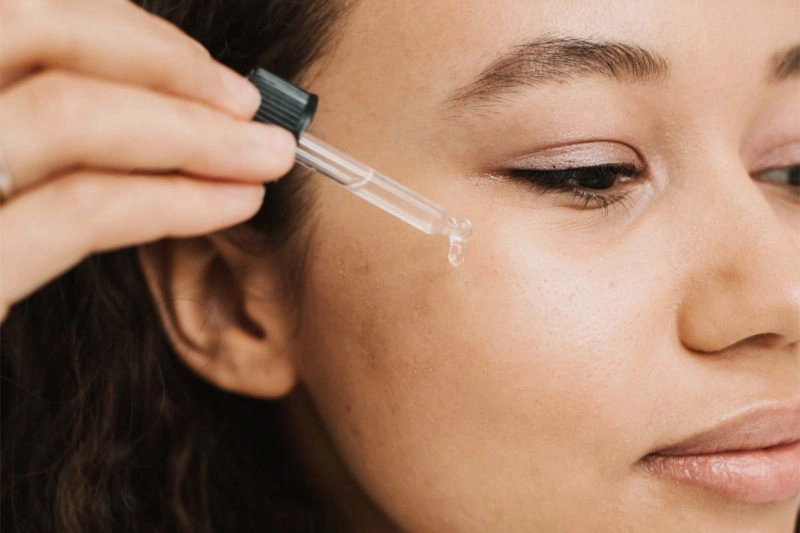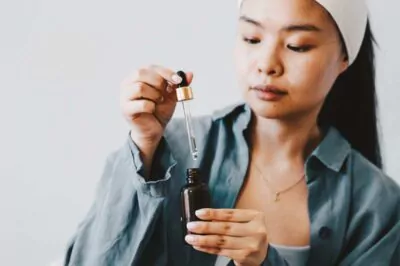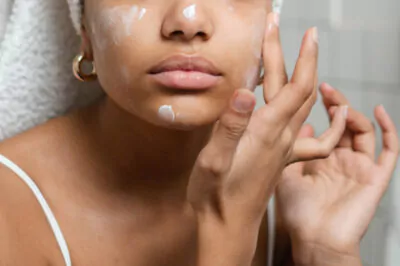Table of Contents[Hide][Show]
Can you use AHA, BHA, and Vitamin C together? The short answer is yes, but with careful consideration. AHAs (Alpha Hydroxy Acids) and BHAs (Beta Hydroxy Acids) are exfoliants and help unclog pores, while Vitamin C is a potent antioxidant that brightens skin and improves your skin look. However, combining these active ingredients isn’t as simple as layering them all at once. The key lies in understanding how to incorporate them into your skin care routine effectively.
In this article, we’ll explore the science behind these ingredients, how to use them safely together, and what results you can expect.
What Are AHAs?
Also known as alpha hydroxy acids, AHAs are water-soluble acids derived from sugary fruits (or honey). The main purpose of AHAs in your skin care routine is to peel away the skin surface and expose a smoother-looking layer. Unlike physical scrubs, AHAs work to bind and dissolve build-up without scrubbing your face, which can sometimes irritate your skin (if sensitive).
When incorporating AHAs into your skin care routine, it’s important to understand how to use them effectively. Check out our guide on how to use AHAs to ensure you’re getting the most out of these powerful ingredients.
What Are BHAs?
BHA, alternatively known as beta hydroxy acid, is oil-soluble and more penetrating than AHAs. This means they can go deeper into the skin to exfoliate it and remove excess natural oils on the skin. If your skin is dry, be careful when using BHAs or the frequency of use since they are a little stronger and can cause some irritation on sensitive skin or an imbalance of oil production.
What Is Vitamin C?
Vitamin C, also known as ascorbic acid, is a potent antioxidant that plays a crucial role in skin care. Vitamin C offers numerous benefits for the skin:
- Antioxidant protection: Vitamin C helps protect the skin from environmental stressors like UV radiation and pollution.
- Skin firmness: With antioxidant properties, it can help maintain the appearance of skin firmness and renew the look of your skin.
- Brightening effect: Vitamin C can help fade the appearance of dark spots and even out the look of your skin tone.
- Lessens the appearance of temporary redness: It can help reduce temporary redness on your skin and bring a calming sensation.
Why Should You Use Vitamin C with AHAs and BHAs? The Science Behind The Combination

According to research by Pinnell and colleagues at Duke University in 2001, ascorbic acid can effectively penetrate the skin barrier when formulated in a solution with a pH of 3.5 or lower. This acidic environment is crucial for optimal absorption and efficacy of vitamin C in your skin care journey.
AHAs and BHAs can help create an optimal acidic environment for Vitamin C absorption. By lowering the skin’s pH, they may enhance the penetration and efficacy of Vitamin C.
While Vitamin C works as an antioxidant and promotes skin vitality, AHAs and BHAs exfoliate the skin and improve the appearance of its texture. This combination can lead to brighter, smoother, and more even-toned skin.
Despite their acidic nature, these ingredients can actually benefit the skin barrier when used correctly. A 2010 study by Hachem and colleagues showed that hyper-acidifying the skin barrier with polyhydroxy acids led to a stronger appearing skin barrier, partly by increasing ceramide production and inhibiting their breakdown.
It’s important to note that while this combination can be beneficial, it may also increase the risk of skin irritation, especially for those with sensitive skin. The key lies in proper application and gradual introduction of these ingredients into your skin care routine.
How To Use AHA, BHA and Vitamin C Together

For the best efficacy, we recommend using lactic acid and vitamin C together. The order of application and timing are crucial for maximizing benefits while minimizing potential irritation.
Layering Vitamin C + AHA/BHA:
- Cleanse your skin thoroughly: Start with a gentle, pH-balanced cleanser to remove any dirt, oil, or makeup.
- Apply your acid exfoliant: If you’re using an AHA or BHA product, apply this first. The lower pH of these products can help create an optimal environment for Vitamin C absorption.
Allow your acid exfoliant to fully absorb before rinsing off (if this is, in fact, a rinse-off product, such as our Resurfacing Facial Exfoliant. (Be sure to always read the recommended usage from the company of the product you are using.)
- Apply Vitamin C serum: After using the acid exfoliant and rinsing your skin, apply your Vitamin C serum (we suggest using your favorite Annmarie Skin Care serum mixed with a few drops of our Brighten Concentrated Boosting Elixir. Look for products containing tetrahexyldecyl ascorbate (THDA), as this is one of the most stable forms of oil-soluble vitamin C that we have found–effective and suitable for all skin types. Follow with moisturizer: After your Vitamin C serum has absorbed (usually about 5-10 minutes), apply a face oil moisturizer to help lock in the active ingredients and provide hydration. Be sure to mist your face lightly with your preferred facial toning mist to allow better absorption of your facial oil.
- Finish with sunscreen (during the day): Always end your morning routine with a broad-spectrum sunscreen, as both acids and Vitamin C can increase skin sensitivity to UV rays.
Ever wonder why we’re always talking about wait times in skin care? It all comes down to something called “free acid concentration.” Don’t worry, we’re not going to make you sit through a chemistry lesson, but here’s the gist:
Free acid concentration is all about how much of the acid in your product that can be effective for your skin. The lower the pH, the higher the free acid concentration, which can increase the product’s potential effectiveness but also increase the risk of skin irritation.
When layering AHA/BHA and Vitamin C products, consider the following guidelines:
- Order of Application: Apply products from lowest to highest pH. Typically, this means applying your AHA or BHA product first, followed by Vitamin C. However, if your Vitamin C product has a lower pH or if the acid product has a thicker texture, reverse this order.
- Waiting Time: The waiting time between layers depends on the pH difference between your products:
- If your acid and Vitamin C products have similar pH levels (within 1.0 of each other), you can apply them one after the other without significant waiting time. Apply your second layer once the first one has absorbed and your skin feels dry to the touch.
- If there’s a bigger gap between the pH levels (a difference of more than 1.0 or 2.0), incorporate a waiting time of up to 30 minutes between applications. This allows each product to work at its optimal pH range.
But remember, your skin is unique! These are just guidelines, not hard and fast rules. If your skin feels irritated, try waiting a bit longer between products or using them less often. It’s all about finding that sweet spot for your own skin.
Using AHAs, BHAs and Vitamin C at Different Times
For those with sensitive skin or those new to using these active ingredients, it may be beneficial to use AHAs, BHAs, and Vitamin C at different times. Here are some strategies:
- Morning vs. Evening: Use Vitamin C in the morning to take advantage of its antioxidant properties which can help against environmental stressors. Then use AHAs or BHAs in the evening.
- Alternating Days: If you’re concerned about how your sensitive skin will react to vitamin C, try using it on alternate days from your AHAs or BHAs. This approach allows your skin to gradually acclimate to each active ingredient without overwhelming it.
- Different Parts of Your Routine: Use a cleanser containing AHA or BHA, followed by a Vitamin C serum. This method allows you to incorporate both ingredients without directly layering them or using them in their most active form.
- Seasonal Adjustment: Some people find success using Vitamin C more frequently in the summer (for its photoprotective effects) and AHAs/BHAs more in the winter (for exfoliation).
Some Tips for Safe Use
When combining AHAs, BHAs, and Vitamin C in your skin care routine, consider these specific tips to maximize efficacy and minimize irritation:
- pH Compatibility: Pay close attention to the pH levels of your products. As per the source, if your AHA/BHA and Vitamin C products have pH levels within 1.0 of each other, you can use them together without waiting. For larger pH gaps, wait up to 30 minutes between applications, especially when directly layering and not using rinse off acid exfoliants
- Timing Strategy: Consider using Vitamin C in the morning for its antioxidant protection against UV and environmental damage, and AHA/BHA in the evening.
- Concentration Matters: Start with lower concentrations of AHA/BHA (around 5-7%) and Vitamin C (around 10-15%) when using them together. Gradually increase as your skin tolerates.
- Layering Technique: Apply your products from thinnest to thickest consistency. Typically, this means AHA/BHA first, then Vitamin C serum, followed by moisturizer.
- Alternate Day Usage: If your skin is sensitive, consider alternating AHA/BHA and Vitamin C on different days. For example, use AHA/BHA one night, Vitamin C the next. We also recommend giving your skin a break and incorporating exfoliation with an acid exfoliant only once per week.
- Formulation Compatibility: Oil-soluble BHAs (like salicylic acid) pair well with oil-based or emulsified Vitamin C formulations. Water-soluble AHAs (like lactic acid) work well with water-based Vitamin C serums (like Brighten elixir blended with any of our serums).
- Buffer with Niacinamide: If you experience irritation, consider introducing niacinamide into your routine. Layering niacinamide and Vitamin C can help strengthen the appearance of your skin barrier, making it more resilient to potential irritation from AHAs, BHAs, and Vitamin C.
What Results Can You Expect?
When effectively combining AHAs, BHAs, and Vitamin C in your skin care routine, you can anticipate a range of beneficial results. The synergistic effects of these ingredients work to enhance your skin’s overall health and appearance.
The exfoliating properties of AHAs and BHAs work in tandem to provide both surface and deep pore cleansing. This dual-action exfoliation can lead to noticeably smoother skin texture and accelerated skin revitalization, revealing fresher, more radiant looking skin.
For those dealing with the occasional breakout concerns, this combination can be particularly beneficial. BHAs, especially salicylic acid, can cleanse pores and help control the look of excess oil on your skin. When paired with the antioxidant properties of Vitamin C, this can lead to a reduction in clogged pores and impurities.
The antioxidant properties of Vitamin C, combined with the skin-renewing effects of AHAs and BHAs, also provide enhanced protection against environmental stressors. This can lead to a visible reduction in uneven skin, contributing to the appearance of a more even skin tone.
While the combination of AHAs, BHAs, and Vitamin C can offer significant benefits, it’s crucial to be aware of potential side effects. These may include:
- Skin irritation, especially for those with sensitive skin
- Redness or dryness
- Increased sun sensitivity
- Potential over-exfoliation with improper use
It’s always recommended to introduce these ingredients gradually into your skin care routine, monitoring your skin’s response carefully. If you experience persistent irritation or adverse effects, it may be beneficial to reduce the frequency of use or consult with a dermatologist for personalized advice.
Choosing the Right Products
When selecting skin care products containing AHAs, BHAs, and Vitamin C, it’s essential to choose formulations that are not only effective but also gentle on your skin. Look for products that combine these active ingredients with soothing and nourishing components to minimize potential irritation.
Annmarie Skin Care’s Wild Alchemy Collection offers a range of products that incorporate these beneficial ingredients in balanced, skin-friendly formulations:
- Wild Fruit Serum: This serum features Vitamin C to brighten and even skin tone while also providing antioxidant protection.
- Brighten–Concentrated Boosting Elixir: A potent and concentrated Vitamin C elixir for those seeking a radiant complexion.
- Resurfacing Facial Exfoliant: Contains honey-derived lactic acid (an AHA) for gentle exfoliation without over-stripping the skin.
These products are formulated with organic and wildcrafted ingredients, making them suitable for those who prefer natural skin care solutions. They allow you to incorporate AHAs and Vitamin C into your routine effectively, while the carefully balanced formulations help minimize the risk of irritation.








Leave a Reply